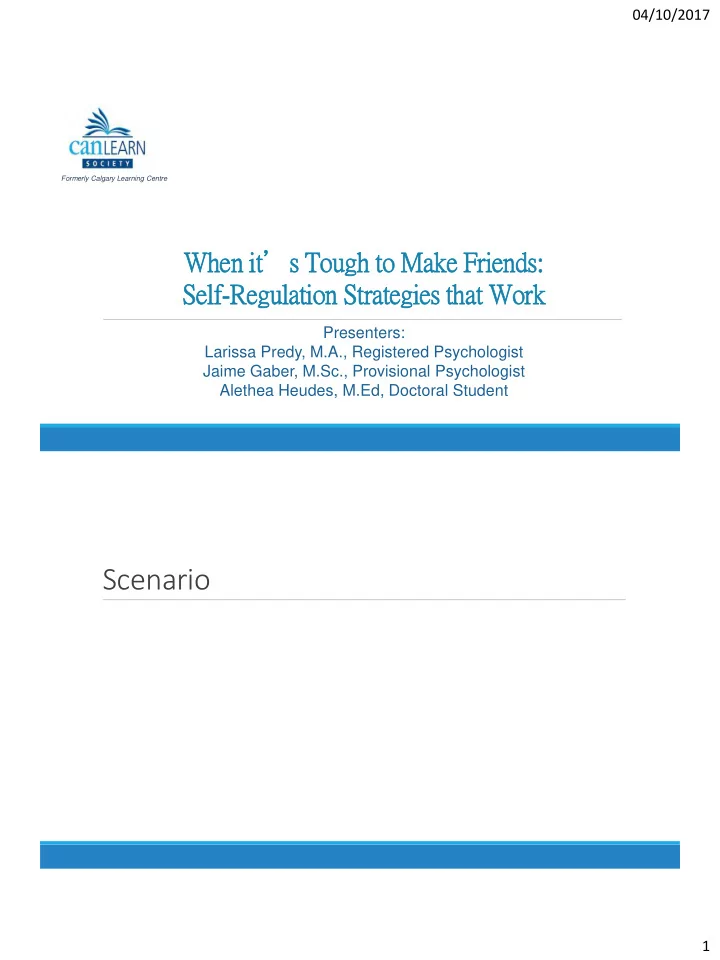

04/10/2017 Formerly Calgary Learning Centre When it’s Tough to Make Friends: Self-Regulation Strategies that Work Presenters: Larissa Predy, M.A., Registered Psychologist Jaime Gaber, M.Sc., Provisional Psychologist Alethea Heudes, M.Ed, Doctoral Student Scenario 1
04/10/2017 What is self-regulation, anyway? • Comes in different forms • The ability to control and direct one's own feelings, thoughts and actions. • Developmental in nature (just like learning to walk, talk, and read) • Can develop with practice and be taught in the classroom https://www.youtube.com/watch?v=B7FSYKcF1pc Self-Regulation by age and stage The frontal lobes undergo two periods of rapid growth: o one during infancy o another from about 4 to 7 years Emotional awareness Metacognition Introspection 2
04/10/2017 Why Focus on Pro-Social Behaviour in the Classroom? What is Pro-Social Behaviour? Helping others Obeying rules Conforming to socially acceptable behaviour Cooperating with others Self-belief and confidence Environment of safety for taking risks Social Emotional Impact on Learning Findings from studies of children participating in social-emotional programs: Improved academic performance – test and grade scores (11% gain) Students are more likely to attend school Students feel more connected to their schools 3
04/10/2017 Social Emotional Impact on Learning Findings from studies of children participating in social-emotional programs: Reduced conduct problems and high – risk behaviors Enhanced social/emotional skills Improved attitudes towards self and others Enhanced positive behaviors What We Teach EXPAND EMOTIONAL VOCABULARY TEACH EXPECTED AND UNEXPECTED 4
04/10/2017 What We Teach TEACH COPING STRATEGIES POSITIVE REINFORCEMENT Expanding Emotional Vocabulary Give children a vocabulary to describe their feelings Teach children to use a framework to categorize how they're feeling The Zones of Regulation 5
04/10/2017 Expected and Unexpected Behaviour Build self-awareness and knowledge of social expectations Examples 6
04/10/2017 More Examples Coping Strategies Changing unhelpful thoughts to helpful thoughts Calm-down cards/cool down kits Relaxation Using I messages to communicate feelings 7
04/10/2017 Positive Reinforcement Sheldon Trains Penny using Operant Conditioning (Positive Reinforcement) https://www.youtube.com/watch?v=qy_mIEnnlF4 Positive Reinforcement Positive Peer Reporting If students can learn to report problem behaviors of their peers, they can also be taught to monitor and report instances of prosocial or appropriate behaviors from peers. How it works: Children are told they will have the opportunity to earn reinforcement (e.g., tokens) for noticing and reporting a peer’s positive behavior . Procedures ◦ A target student is randomly selected as “Star of the Week” ◦ During a specified time of day a group meeting is held where children are given an opportunity to report aloud any positive behaviors they observed from the star student that day. ◦ Each child that reports a positive behavior earns a reinforcer (e.g., school-wide token). 8
04/10/2017 Positive Reinforcement TOOTLING! During Positive Peer Reporting (PPR) students focus their attention on the positive behaviors of one selected student . In contrast, Tootling provides an opportunity for the entire class to report on positive behaviors of any student in the group. Description: Tootling is like tattling in that students report the behavior of another child. However, tootles can only report instances of desired/appropriate behavior (e.g., positive behaviour expectations). Procedures: Teacher introduces and defines tootling. Provides instruction for how to tootle & sets a tootling goal. Students record “tootles” using an index card that is taped to their desk. At the end of the day the cards are turned in to the teacher. The next day the teacher reports out on the number of tootles recorded. Positive Reinforcement The Positive Behaviour Game The positive behaviour game is played throughout the day and rewards children for displaying appropriate behaviours toward peers. Points are earned by all students and add up to a classwide reward when a specified goal is reached. Students DO NOT lose rewards that have been earned (this is where consequences come in, but they are kept separate from the game) 9
04/10/2017 Positive Reinforcement Consequences for problem behaviour If students have the skills , know the expectations , and are motivated to perform the appropriate behaviour , a problem behaviour may have a specified and expected consequence (e.g., hitting results in a loss of privilege). Be careful! We must consider the function of the behaviour For example, imagine a child who throws his pencil during desk work time – you consequence by removing the child from the classroom, or requiring that student to clean up a bigger mess – BUT, did that just serve the purpose of the behaviour? Did that child want to avoid the desk work? Is the behaviour a function of something else? The more clearly you teach the expected behaviours, the easier it will be to reinforce the positives and consequence the negatives 10
Recommend
More recommend